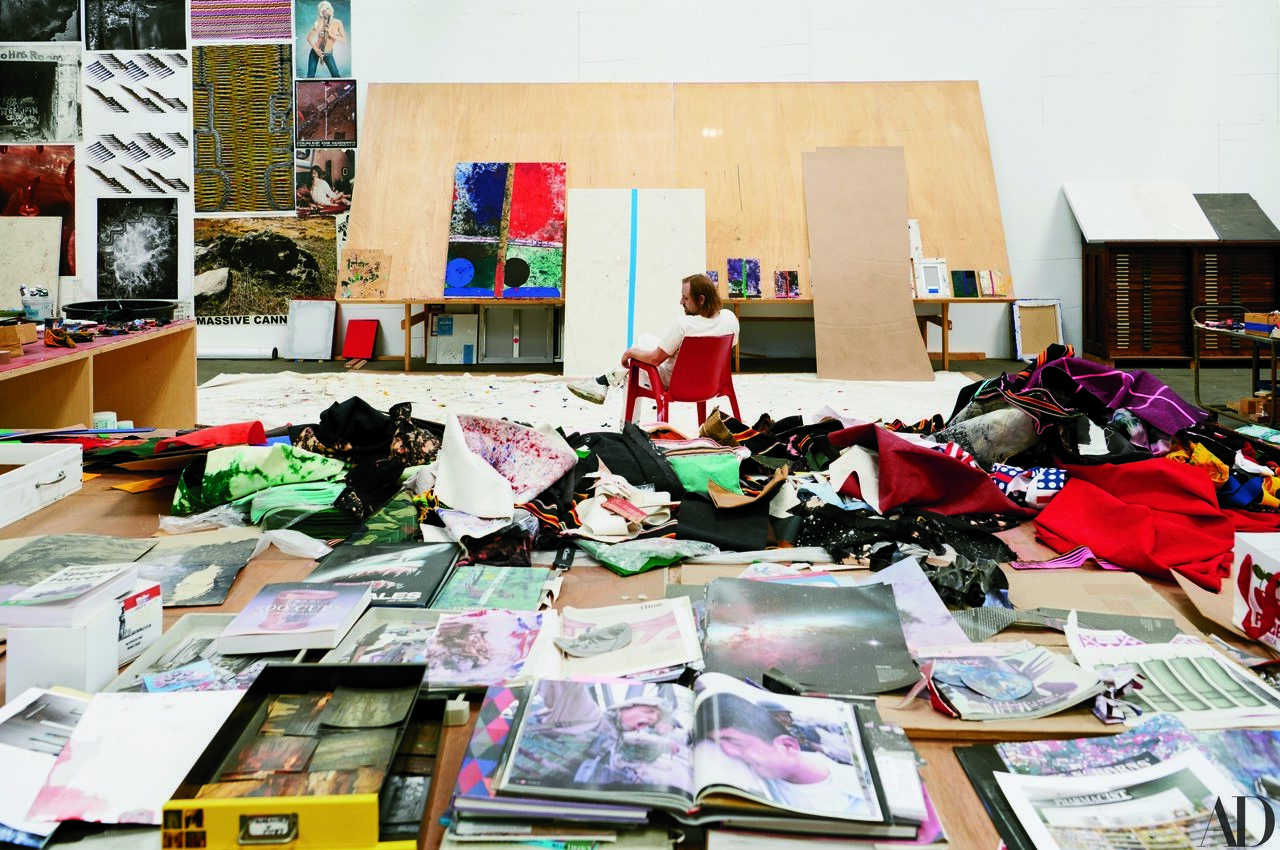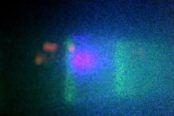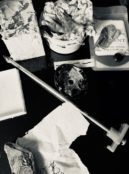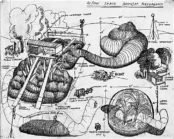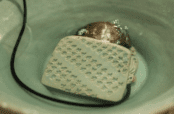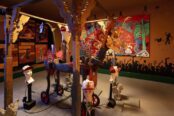As artists where are we? Let us consider the artist’s studio space as a potential site of ‘Jetztzeit’ as defined by Benjamin in Theses on the Philosophy of History (1940). Thinking of the artist’s studio as a space for the occurrence of the new and furthermore as a space where a radical relationship to: time, tradition, and practice emerges for the artist in this mode. This is a quality of an approach that can be thought of as an ongoing and self-reproducing archaeological site. The artist Sterling Ruby will be considered as an exponent of this approach and examples drawn from his practice will be used to highlight the use of space, practice methods and overall intentionality in the approach.
Jetzteit
The term ‘Jetztzeit’ can be translated as ‘now time’ but is a relatively complex idea that requires some explanation; the entry below from a critical theory dictionary is a useful starting point,
Walter Benjamin uses this term in his ‘Theses on the Philosophy of History’ to describe a notion of time that is ripe with revolutionary possibility, time that has been detached from the continuum of history. It is time at a standstill, poised, filled with energy, and ready to take what Benjamin called the ‘tiger’s leap’ into the future. It isn’t naturally occurring, however, and takes the intervention of the artist or revolutionary to produce it by ‘blasting’ it free from the ceaseless flow in which it would otherwise be trapped. Benjamin contrasts jetztzeit with the ‘homogeneous empty time’ of the ruling class, which is history written from the perspective of the victors (as Benedict Anderson shows in his account of nation as imagined community). (Oxfordreference.com, 2020)
This entry posits the artist or revolutionary as the intervening force who blasts at the ‘ceaseless flow’ of empty time and as such draws attention to two different positions. The one of interest here is that of the artist, although in relation to the ‘ceaseless flow’ which I understand as a hegemonic concept of history and of time that Benjamin wants to do away with perhaps the artist and revolutionary could be thought to be interchangeable at least in their shared endeavour to enact shifts in perception and attitude.
For clarity around this term Beiner (1984) is useful, there Benjamin is seen as shifting the focus of historical materialism from ‘revolutionary expectations for the future’ (:424) to a ‘relation to the past, namely, a redemptive relation’ (:424). Beiner uses the term ‘comporting’ to describe the way Benjamin encourages a different relation to the past one which looks to ‘fragments’ rather than a ‘totality’ and which seeks ‘to make the fragments whole again’ (:424); as for Benjamin according to Beiner history is, ‘radically fragmented’. Beiner points out this is a departure from the, ‘rationally intelligible process’ of Hegel and goes on to muse on Scholem’s feeling that Benjamin is less materialist but metaphysical and theological in this text. In attempting to explain this difference Beiner quoting Benjamin puts it thusly,
The historicist “tells the sequence of events like the beads of a rosary” (thesis A). The historical materialist, in contrast …sees history as living and throbbing with revolutionary possibilities and strives to establish a messianic relation to the past. Beiner (1984:427)
Here Beiner addresses ‘Jetztzeit’ directly to make sense of these two positions on history,
Jetziet (now time), in which the present and past are drawn into a messianic relation (thesis A). Through shock, arrest, and blasting, historical materialism replaces the homogenous empty time of historicism. Biener (1984:247)
Beiner clearly draws attention to the idea that the past as solid and inevitable, that is as ‘inert’ thing a ‘chain of events’ is what Benjamin undermines with his view of history as a fragmented multifarious entity which requires redemption ‘a ruined past in need of salvation, a fallen ancestor in need of awakening (thesis IX, Benjamin quoted in Beiner, 1984:427). In relation to ‘Jetziet’ Beiner draws attention to Benjamin’s problematizing of progress (:428). Belief in progress is seen as ‘complacent’ Beiner emphasizes Benjamin’s contrast between the wrongheaded view of social democracy that it is ‘moving with the current’ (Benjamin quoted in Beiner 1984:428) and Benjamin’s assertion that a ‘historical materialist “regards it as his task to brush history against the grain” (thesis VIII)’ (Benjamin quoted in Beiner 1984:428).
We might understand this as a reinterpretation or as an understanding that the past is malleable and shifting, constructed from fragments in the present; Beiner though draws our attention to a stark jeopardy highlighted in Benjamin, ‘The ever-present danger, as Benjamin says in thesis V, is that the image of the past “is never seen again” this image “flits by” and it therefore must be seized before its gone.’ (Beiner, 1984:428). This can be understood in relation to another example where Beiner shows the different conceptions of positive or revolutionary change between Marx and Benjamin; Marx characterised the revolution as a train driven along by the force of its participants (this again relates to the notion of progress that Benjamin undermines as complacent) for Benjamin history itself is this train which must be halted,
The Benjaminian histographor wishes to get off this train because, far from being elated by the destination it promises, he continues to be troubled by the whistle-stops that have been left behind… (Beiner, 1984:430)
I would share the following reflections: what can be drawn from these insights in relation to the artist studio?
- Agency is something that emerges in a relation with the past in the present.
- ‘Messianic’ refers to the ability of an individual to redeem the past in service to the present.
- Reinterpretation, improvisation and intension are all requirements of the blasting at the ‘ceaseless flow’ that Benjamin refers to.
Perhaps most pertinently it would be key to understand the answer to the following,
- Can there be an art of the ceaseless flow?
- Can there be an art of the ‘Jetztzeit’?
Further to this the following question must be addressed, how does history exist in the artist’s studio?
History in the Artist’s Studio
A studio of course is a physical space where the artist makes their work, but how this is characterised is telling in relation to various ideas of what the artist is: – a master working like a genius, a creator stitching together meaning, a recluse seeking sanctuary, a subjectivity on trial. These are some of the ways scholars characterise the artist and thus the space which supports those manifestations of ‘artist’. Below I outline examples of those manifestations.
Bhabha discussed later via Respina (2019) appears to utilise the studio as an open social space akin to theatre while Nead (1995) reflecting on La Belle Noiseuse and Jacques Rivette’s idea that the studio is a deliberately secluded private space with a clear boundary. Here the idea of histories entry into the studio is seen as primarily through the mind, habits and practice of the artist; their learned practices in terms of making (tradition) and their specific knowledge of and reflections on their inherited situation. Further to this following Pollock (1988:36) and Orton and Pollock (1996:252) history is seen as specificity of place and time, a context in the present that the artist is ‘working on’ this is history in all its overwhelming enormity blasted at by the labour of a consciousness working on itself and its culture through art practice.
To understand the archaeological site conception of the studio which I posit encompasses various other ideas of artist studio and of artist it’s useful to have these other conceptions in mind.
Master
This is the idea that the studio is a perfunctory tool of the great man and is secondary to their personality, presence and inert creativity. Nead illustrates the trope of the master in reference to images of Picasso in his studio ‘The studio becomes the corporeal extension of the artist and traces of the body are detected at all turns’ (Nead, 1995:62). Going on to clearly indicate the necessarily enigmatic status of this myth ‘The studio and the artist thus are made to collaborate in a reciprocal reinforcement of the mythology of the artist/genius and the enigma of the artistic process’ (Nead, 1995:67). The self-mythologizing ‘enigma’ obfuscates processes and centres attention on the special individual as the seat of reason.
Recluse
This is the idea that the studio is a space, a retreat from or sanctuary from the world, a romanticised view of the space that evidences an actual distance from the reality of the studio,
Jacques Rivette visualizes the studio-sanctuary in a particularly vivid way in La Belle Noiseuse. Although the artist is portrayed as highly socialized and is contextualized by his relationships with his wife, his agent, access to exhibitions, etc., his studio is represented as a discrete space, separated from this other world of social interaction. Nead (1995:67)
But if history enters through, in part the mind of the artist then how can the studio be seen as a sanctuary? As a quiet place yes, perhaps devoid of other people even but no more a sanctuary from the ‘ceaseless flow’ of history than the inside of our heads; our minds are the Trojan horse of any sanctuary which might see itself as separate in a meaningful way from Benjamin’s ‘empty time’ or to put it another way a meta-space away from the forces that Benjamin speaks of. If absence of this flow is not possible in a specifically demarcated space, the studio, then perhaps reordering or ‘blasting’ is ‘…to brush history against the grain” (thesis VIII)’ (Benjamin quoted in Beiner 1984:428).
Meaning Maker
In reference to artist Huma Bhabha, Respina (2019) sees the studio as a site for meaning making, the forging of links in a possible narrative ‘A photograph of Rodin in his studio served as the initial inspiration for this work, having prompted the artist to imagine the entirety of her studio as a sculpture or stage upon which narratives might unfold’ (:23); this acknowledges a preformative aspect of the studio, could this be seen as the collecting together of ‘fragments’ that Benjamin refers to in order to offer new trajectories for thinking addressed to an audience (even an imagined audience).
The Subject on Trial
A more complex situation arises where multiple forces intersect in both the mind and context of the artist in space,
Finally, I indicated the importance of the space from which the representation is made, which is both the working space of the artist, the studio and its social and psychic relations and the social space of the artist in her social, gendered, sexual and psychic specificity: her generation and geography, as it were. To pick up the historical meanings of a work requires us to move through all three (Pollock 1988:36).
These indexes: 1 the working space; 2 the artist as embodied; 3 social historical context, provide the circumstances for acts of creativity which are either in the ‘ceaseless flow’ or brushing against the grain to lend Benjamin’s terminology. Orton and Pollock highlight the hyper reflective nature of this space and how subjectivity performs differently there from both the myth of a sanctuary (which this essay would assert it never was) or as a tool for the ‘masters’ output, here the idea of a spontaneously autonomous individual with inert or automatic agency is also rejected,
To go beyond modernist criticism is to defetishise and decommodify the gesture/signature/author complex by returning both to the labouring, producing body and to subjectivity – in process and on trial- in history… we could explore the practice of painting, in social as well as symbolic space, as a metonymic trace, an index of a socially formed, psychically enacted subjectivity at work, both consciously and unconsciously, upon its own and its cultures materials (Orton and Pollock, 1996:252).
To recall Benjamin’s view of the train of history and apply it here; the inert or automatic agency we think we have is part of the ceaseless flow that we enter into when we act without reflective processes such as those enacted in the space that Orton and Pollock describe, where the subject works ‘both consciously and unconsciously, upon its own and its cultures materials,’ (ibid) this would seem to undermine notions of agency in either the conception of artist as master or artist as recluse since the master works on his cultures materials while the recluse seeks sanctuary from them.
The sense of a stitching together of meaning and of the subject working on its own, and its and its cultures, materials is the subjective position I would embrace. The notion of both the master and the recluse requires an idea that history is something outside both the mind and the studio and which seems to grant too much distance, a distance that actually does not exist, but which may be a necessary mode at given times in a creative process, Ruby discussed later moves between these positions as and when is necessary,
Ruby’s studio practice typically involves his assistants helping make his sculptures. But none of them touch his sprayed paintings. Painting the VIVIDS is a private act. Ruby admitted to having been “holed up in the studio” while executing them. The result is an art of subjectivity without subject (Wang, 2014:17).
The shift posited here imagines the studio in contrast as a permeable space, inside and outside simultaneously which encompasses the above categories and where the practice of art is the vessel for the movement between these states.
In this way the studio is understood as a more alive site of multiple layers of meaning, history and relationships; a convergence of a historical present that is recognised by the practitioner and can thereby be worked on which represents a shift from the specific categories above.
Self-Reproducing Archaeological Site
If history enters the studio in the form of the artist’s habits, obsessions and ideas as well as being a cultural force that is outside of the individual; then the idea of a layered and permeable space which allows the artist to work on both these features is essential. The studio is an extension of the mind (which allows the artist to physically reorder and manipulate its materials and features) and at the same time a site subject to cultural forces that opens to other people.

It is my assertion that the space of the studio in the mode of archaeological site facilitates ‘Jetztzeit’ in the same way that Bejamin’s own writing as a historical materialist places him as an agent working against the ceaseless flow. An artist who wishes to enter into the comfort of producing either fashion or tradition would be in this ceaseless flow. Furthermore, regarding the validity of the application of ‘Jetztzeit’ to a studio space we might consider that in the ultimate connectivity and social media environment all spaces within that grid have become historicised, in a synchronicity of events therefore levelling any hierarchy of space that would assign specific functions to some and deny them to others.
Returning to Ruby we can ask how does the idea of an archaeological site work when referring to the studio space? And what are the characteristics of a studio in this mode?
Ruby’s own studio is vast, entire areas have equipment for painting, 3d construction and ceramic work as well as tables and shelves of old work and a plethora of drawn and written ideas both original and source material are catalogued there (see Louisiana Channel, 2016).
Some works appear displayed almost as they might be in a gallery while others are very much under construction. In this sense Ruby’s space or situation does separate him from the position of master or recluse discussed earlier: – Ruby by comparison is able to create a space which extends the function of his own memory and mind and as being at once public and a private space, permeable may be the best term. Ruby is able to not only walk around as it were in his own head but open it up to others. The space then is multi layered and as such can be mined. Detritus shoved aside in the pursuit of one vein of enquiry is mixed with some other surface ephemera and might produce an idea or outcome later claimed by the artist who must be ready to seize this as they occur. Ruby reflects on the status of this multifarious space,
What happens when things are buried, dug up re- assessed, buried, dug up, re-assessed? how does the decomposition or deconstruction of these things create a broader expanse of confusion. The burden of art historical times has given artists of now baggage, lineage to collage that creates a hybrid when put together (Ruby in gagosianviewingroom.com, 2019).
Ruby explains the artist’s relation in such a space, ‘An anthropological or archaeological sense of looking at the past, the present and at potentially what might be the future of representations of culture’ (Ruby in gagosianviewingroom.com, 2019).
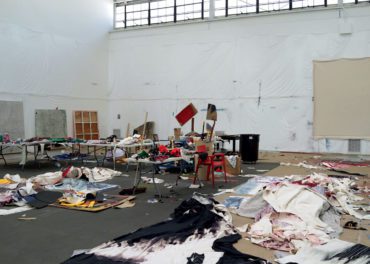
This relationship to the studio means that the artist needs to be comfortable working with and across the borders of specific mediums and subject matter and happy for the space to be permeable to other people and as such other people’s ideas and comments ‘Studio as not just the now and not some comfortable historic past (the studio should) pendulate uncomfortably between stratus’ (Ruby in gagosianviewingroom.com, 2019) here Ruby refers to the tension that the studio helps to retain for the artist resisting the temptation to stray into the comfort of the now (fashion) or then (tradition) both aspects of Benjamin’s ‘ceaseless flow’.

Furthermore, in such a site the subject encounters memories crystallised both their own in the form of old works and ideas and in the form of secondary source materials as well as various mediums themselves carriers of historic meaning,
The angel of history prefers to tarry at the ruins of the past in order to “awaken the dead,” to make whole what has been shattered. To this corresponds the redemptive function of historical reflection, the saving power of remembrance. The historian desires to keep faith with the past, and it is in this that his or her revolutionary commitment is expressed (Beiner, 1984).
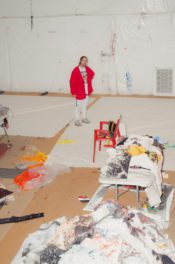
Further stating that ‘remembrance shall prevail over soothsaying’ (Benjamin quoted in Beiner, 1984). In this way the studio offers up juxtapositions that can be ‘seized’ before they are “ never seen again” this image “flits by” and it therefore must be seized before its gone.’ (Beiner, 1984:428). So agency emerges not as the master’s intervention or the recluse’s escape but from the toing and froing of the artist in the archaeological studio. The artist here should not be understood as a hapless fisherman waiting for something to come to the surface; while chance and improvisation are key the site of the studio is the product of the artists labour and functions only as an archaeological space when it begins to reproduce itself as a result of the work of the artist. The studio becomes the process along with the subjectivity of the artist and the culture in which they are embedded.
References
Beiner, R. (1984). Walter Benjamin’s Philosophy of History. Political Theory New York, NY, 12(3), pp.423-434.
Frieze (2019). Sterling Ruby in his studio.. [image] Available at: https://frieze.com/article/studio-sterling-ruby [Accessed 22 Jan. 2020].
gagosianviewingroom.com. (2019). Sterling Ruby and Sam Orlofsky Frieze London 2019 Online Viewing Room. Available at: https://gagosian.com/news/2019/11/05/sterling-ruby-sam-orlofsky-video-frieze-london-2019-online-viewing-room/ [Accessed 20 Jan. 2020].
Louisiana Channel (2016). Sterling Ruby Interview: A Bowl of Memories. Available at: https://www.youtube.com/watch?v=9eWgXgLYC_g&feature=youtu.be [Accessed 20 Jan. 2020].
Nead, L. (1995) Visual Mythologies of the Artist and Artistic Creativity. Oxford Art Journal, Vol. 18, No. 2 (1995), pp. 59-69. Oxford University Press.
Orton, F. and Pollock, G. (1996). Avant-gardes and partisans reviewed. Manchester: Manchester University Press.
Oxfordreference.com. (2020). Jetztzeit – Oxford Reference. [online] Available at: https://www.oxfordreference.com/view/10.1093/oi/authority.20110803100020224 [Accessed 20 Jan. 2020].
Pollock, G. (1988) Vision and Difference Feminism, femininity and the histories of art. New York, Routledge.
Respini, E. (2019). Huma Bhabha: They Live. Boston: Yale University Press.
Surface Magazine (2018). Image of Ruby’s studio.. [image] Available at: https://www.youtube.com/watch?v=9WIIYtvLA_Y [Accessed 22 Jan. 2020].
Wang, E (2014) Posthuman Inscape: Sterling Ruby’s VIVIDS Paintings and Subjectivity Without Subject. Gagosian Gallery Hong Kong, Rizzoli International Publications.
Images courtesy of the author and respective sources.

Natalie Andrews is an artist working with a range of mediums, she has shown her work at the Hoxton Arches in London and is currently working on a number of 3d works alongside painting exploring the links between painting and sculpture;
“I am interested in the way that we relate to one another and with space, how the environments we inhabit structure and dictate these relationships and create both opportunities for emancipation but also the deep alienation and separateness.”

